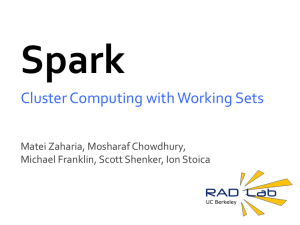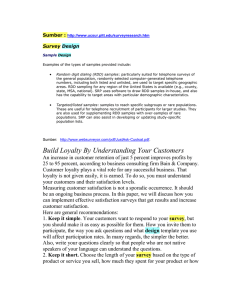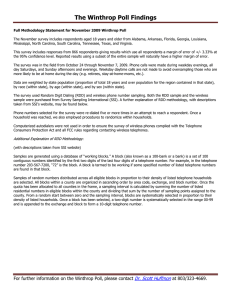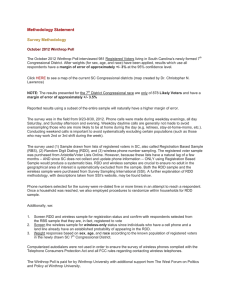Data Engineering How MapReduce Works Shivnath Babu
advertisement
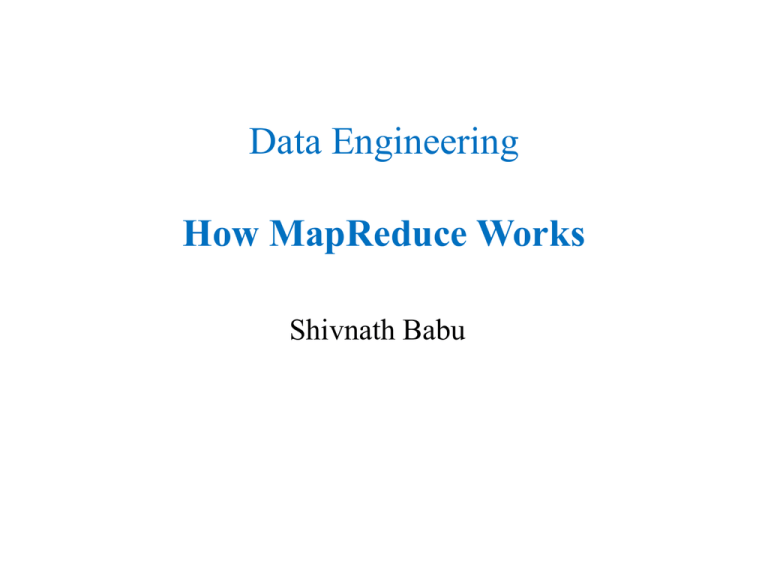
Data Engineering How MapReduce Works Shivnath Babu Lifecycle of a MapReduce Job Map function Reduce function Run this program as a MapReduce job Lifecycle of a MapReduce Job Map function Reduce function Run this program as a MapReduce job Lifecycle of a MapReduce Job Time Input Splits Map Wave 1 Map Wave 2 Reduce Wave 1 Reduce Wave 2 Job Submission Initialization Scheduling Execution Map Task Reduce Tasks Hadoop Distributed File-System (HDFS) Lifecycle of a MapReduce Job Time Input Splits Map Wave 1 Map Wave 2 Reduce Wave 1 Reduce Wave 2 How are the number of splits, number of map and reduce tasks, memory allocation to tasks, etc., determined? Map Map Wave 1 Wave 2 Map Wave 3 Reduce Wave 1 Shuffle Reduce Wave 2 What if #reduces increased to 9? Map Map Wave 1 Wave 2 Map Reduce Reduce Reduce Wave 3 Wave 1 Wave 2 Wave 3 Spark Programming Model Driver Program sc=new SparkContext rDD=sc.textfile(“hdfs:/ /…”) rDD.filter(…) rDD.Cache rDD.Count rDD.map Cluster Manager SparkContext Worker Node Writes Executer Task Cache 14 Executer Task Datanode User (Developer) Worker Node Task … Cache Task Datanode HDFS Taken from http://www.slideshare.net/fabiofumarola1/11-from-hadoop-to-spark-12 Spark Programming Model Driver Program sc=new SparkContext rDD=sc.textfile(“hdfs:/ /…”) rDD.filter(…) rDD.Cache rDD.Count rDD.map Writes User (Developer) 15 RDD (Resilient Distributed Dataset) • • • • • • Immutable Data structure In-memory (explicitly) Fault Tolerant Parallel Data Structure Controlled partitioning to optimize data placement Can be manipulated using a rich set of operators RDD • Programming Interface: Programmer can perform 3 types of operations Transformations • Create a new dataset from an existing one. • Lazy in nature. They are executed only when some action is performed. Actions • • • Example : • Map(func) • Filter(func) • Distinct() 16 Returns to the driver program a value or exports data to a storage system after performing a computation. Example: • Count() • Reduce(funct) • Collect • Take() Persistence • For caching datasets inmemory for future operations. • Option to store on disk or RAM or mixed (Storage Level). • Example: • Persist() • Cache() How Spark works • RDD: Parallel collection with partitions • User application can create RDDs, transform them, and run actions. • This results in a DAG (Directed Acyclic Graph) of operators. • DAG is compiled into stages • Each stage is executed as a collection of Tasks (one Task for each Partition). 17 Summary of Components • Task : The fundamental unit of execution in Spark • Stage: Collection of Tasks that run in parallel • DAG: Logical Graph of RDD operations • RDD : Parallel dataset of objects with partitions 18 Example sc.textFile(“/wiki/pagecounts”) textFile 19 RDD[String] Example sc.textFile(“/wiki/pagecounts”) .map(line => line.split(“\t”)) textFile 20 map RDD[String] RDD[List[String]] Example sc.textFile(“/wiki/pagecounts”) .map(line => line.split(“\t”)) .map(R => (R[0], int(R[1]))) textFile 21 map map RDD[String] RDD[List[String]] RDD[(String, Int)] Example sc.textFile(“/wiki/pagecounts”) .map(line => line.split(“\t”)) .map(R => (R[0], int(R[1]))) .reduceByKey(_+_) textFile 22 map map RDD[String] RDD[List[String]] RDD[(String, Int)] RDD[(String, Int)] reduceByKey Example sc.textFile(“/wiki/pagecounts”) .map(line => line.split(“\t”)) .map(R => (R[0], int(R[1]))) .reduceByKey(_+_, 3) .collect() RDD[String] RDD[List[String]] RDD[(String, Int)] RDD[(String, Int)] Array[(String, Int)] collect reduceByKey 23 Execution Plan Stage 2 Stage 1 collect textFile map map reduceByKey Stages are sequences of RDDs, that don’t have a Shuffle in between 24 Execution Plan Stage 2 Stage 1 collect textFile 1. 2. 3. 4. map map reduceByKey 1. Read shuffle data 2. Final reduce 3. Send result to driver program Read HDFS split Apply both the maps Start partial reduce Write shuffle data Stage 1 Stage 2 25 Stage Execution Task 1 Task 2 Task 2 Task 2 • Create a task for each Partition in the input RDD • Serialize the Task • Schedule and ship Tasks to Slaves And all this happens internally (you don’t have to do anything) 26 Spark Executor (Slave) Fetch Input Core 1 Fetch Input Execute Task Fetch Input Execute Task Write Output Execute Task Write Output Fetch Input Core 2 Write Output Fetch Input Execute Task Execute Task Write Output Fetch Input Core 3 Fetch Input Execute Task Write Output 27 Write Output Execute Task Write Output
